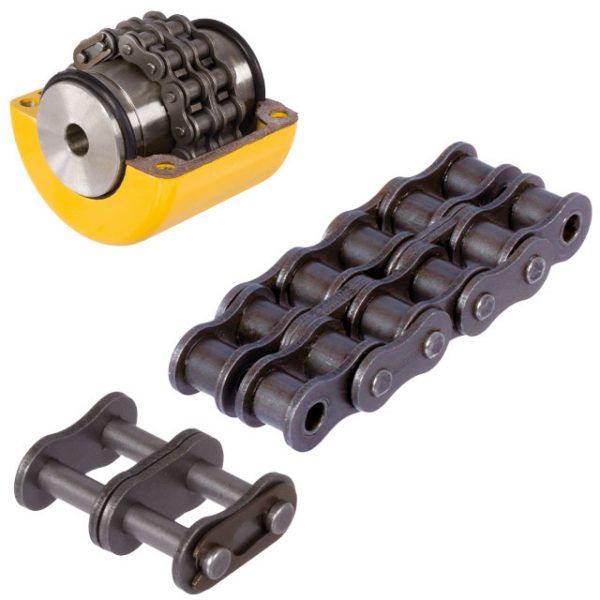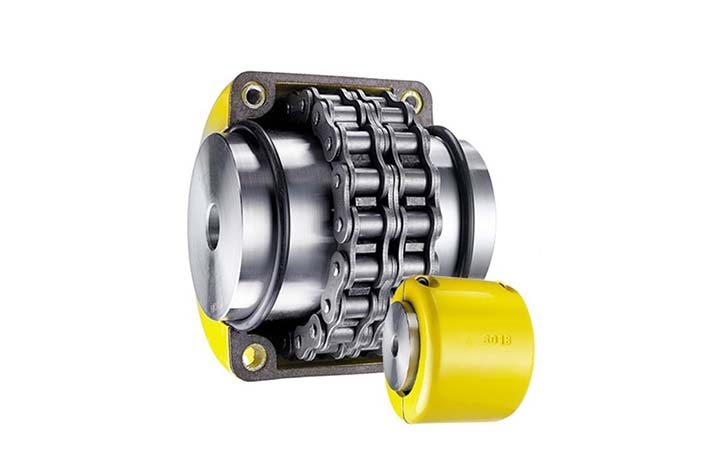Product Description
| Item | Chain Coupling | Model | All |
| Row | Duplex | Application | Machinery Parts |
| Surface Teatment | Self-color/Sand-blasted/Shot-peening | Brand | OEM |
| Package | Poly bag, then box, finally poly-wooden case | Port | Any sea port or airport in China |
| Other Products | |||
| Standard A/B Roller Chain | 08B,10B,12B,16B,40,50,60,80 | Motorcycle Chain | 415,415H,420,428,428H,520,520H,525,530 |
| Bicycle Chain | 410,Z50,Z51,Z80,Z10,RX-11 | Silent Chain | SC3,SC4,SC5,SC6,SC8,SC10 |
| Oil Field Chain | 100G,120G,140G,160G,180G | Side Bow Chain | 40SB,43SB,50SB,60SB,63SB,80SB,08BSB |
| Heavy Duty Cranked Link Chain | 2571,2512,2814,3315,3618, 4571,2184,4824 |
Chain Coupling | 3012,4012,4014,5014,5016,5018,6018,6571, 6571,8018,8571,8571,1571,12018,12571 |
| Double Pitch Conveyor Chain | C2040,C2042,C2050,C2052,C2060, C2062,C2060,C2080,C2082,C2100 |
Welded Chain | |
| Chain with Extended Pins | 08A/10A/12A/16A-D1/D2 | Hollow Pin Chain | 08BHP,10BHP,12BHP,40HP,50HP,60HP,80HP |
| Rubber Top Roller Chain | 08B-G1/G2,10B-G1/G2,12B-G1/G2,16B-G1/G2,20B-G1,24B-G1 | Double Plus Chain | BS25-C206B,BS25-C208A,BS25-C210A,BS30-C212A,BS30-C216A |
| Plastic Chain | PC35,PC40,PC50,PC60 | Palm Oil Chain | 5571,5094,5234,3076,4075,5289,5257,5305 |
| Sugar Mill Chain | 2184,8184, 0571 3, 0571 5,5956 | Paver Chain | P80,P78.1 |
| Paper Mill Chain | 63PF2 | Bottle Washer Chain | P139.7-A2,P140,P150X,P155X,P160X, P165X,P169X |
| Steel Mill Chain | P100,P160,P500 | Leaf Chain | BL523,BL534,BL588,BL634,BL866,BL1244 |
| Agricultural Chain | S45,S55,S55V,A550,CA550,CA624 | Forged Chain | 10160,14218,14226,160,125,200,216,260 |
| Forged Trolley | X348,X458,X678,X698,160 | Cast Chain | CC600,C55,C188,C102B,C132,477,455,488 |
| Overhead Conveyor Forged Chain | 5075-S/HH/HA, 7 Tons, 5 Tons | Detachable Chain | 25,32,42,51,52,55,62,70,72 |
| Snow Chain | D6,8,10,12,14,18,22,24,26,28,30 | Sprockets | Standard, Non-standard |

Can chain couplings be used in high-speed applications?
Chain couplings can be used in certain high-speed applications, but there are limitations and considerations that need to be taken into account. The suitability of chain couplings for high-speed applications depends on factors such as the specific design of the coupling, the chosen chain type, and the operating conditions. Here are some key points to consider:
- Coupling Design: The design of the chain coupling plays a crucial role in determining its suitability for high-speed applications. High-speed chain couplings typically incorporate features that minimize vibration, reduce stress concentrations, and ensure smooth operation. Couplings designed for high-speed use may have additional balancing or damping mechanisms to counteract potential issues associated with centrifugal forces and resonance.
- Chain Type: The type of chain used in the coupling can affect its performance at high speeds. In general, roller chains are commonly used in chain couplings. However, for high-speed applications, special high-speed roller chains or other chain types designed for increased rotational speeds may be required. These chains are designed to minimize friction, reduce wear, and handle the centrifugal forces associated with high-speed operation.
- Bearing Selection: Proper bearing selection is critical for high-speed chain couplings. The bearings used in the coupling should be capable of handling the anticipated speeds and dynamic loads. High-quality, precision bearings with appropriate lubrication are typically necessary to ensure smooth operation and minimize the risk of premature failure.
- Balancing and Vibration: High-speed chain couplings should be properly balanced to minimize vibration and ensure stable operation. Imbalances in rotating components can lead to increased noise, excessive stress, and reduced service life. Balancing techniques such as dynamic balancing or the use of counterweights may be employed to achieve smooth and reliable operation.
- Lubrication: Adequate lubrication is crucial for high-speed chain couplings to minimize friction, reduce wear, and dissipate heat effectively. Proper lubrication practices, including the use of high-quality lubricants and regular maintenance, should be followed to ensure optimal performance and prevent premature failure.
Despite these considerations, it’s important to note that chain couplings may have practical limitations in terms of maximum allowable speeds. The specific speed limitations will depend on factors such as the coupling design, chain type, size, and the operating conditions. It is advisable to consult the manufacturer’s specifications and guidelines to determine the maximum recommended speed for a particular chain coupling.
In certain high-speed applications where chain couplings may not be suitable, alternative coupling types such as flexible disc couplings, gear couplings, or elastomeric couplings specifically designed for high-speed applications may be more appropriate. These couplings are engineered to handle the challenges associated with high rotational speeds, offering improved balance, reduced vibration, and higher speed capabilities.
Overall, when considering the use of chain couplings in high-speed applications, it is essential to carefully evaluate the specific requirements, consult with the manufacturer, and ensure that the coupling is designed and selected to operate safely and reliably at the desired speeds.

Can chain couplings accommodate angular misalignment?
Yes, chain couplings are designed to accommodate a certain degree of angular misalignment between the connected shafts. Angular misalignment refers to the situation where the axes of the two shafts are not perfectly aligned and form an angle with each other.
Chain couplings are flexible in nature, and their design allows for some degree of angular displacement. The flexibility is primarily provided by the roller chain, which can bend and adjust to a certain extent to accommodate the misalignment. This flexibility helps to reduce the stress on the coupling components and allows for smoother operation even in the presence of angular misalignment.
However, it is important to note that chain couplings have limitations in terms of angular misalignment. Excessive angular misalignment beyond the specified limits can lead to increased stress, accelerated wear, and potential coupling failure. The manufacturer’s specifications and guidelines should be followed to ensure that the angular misalignment remains within the acceptable range for the specific chain coupling being used.
Regular inspection and maintenance of the chain coupling are also essential to identify and address any misalignment issues. If significant angular misalignment is detected, corrective measures should be taken, such as realigning the shafts or considering alternative coupling options that are better suited for the specific misalignment requirements.
It is worth mentioning that chain couplings are more tolerant of angular misalignment compared to some other types of couplings, such as rigid or gear couplings. However, it is still important to strive for proper alignment during installation and minimize any excessive misalignment to ensure optimal performance, reliability, and longevity of the chain coupling and the connected machinery or equipment.

How does a chain coupling work?
A chain coupling works by connecting two rotating shafts using a roller chain and sprockets. The sprockets have teeth that engage with the rollers of the chain, creating a positive drive mechanism.
When the first shaft rotates, it drives the sprocket attached to it. The engaged chain then transfers the motion to the second sprocket and the second shaft, causing it to rotate as well.
The chain coupling design allows for flexibility and misalignment compensation. In the presence of angular misalignment between the shafts, the chain can accommodate the deviation by flexing and adjusting its position on the sprockets. Similarly, if there is parallel misalignment or axial displacement, the chain coupling can flex and adjust to maintain proper engagement and transmit torque between the shafts.
The engagement between the sprocket teeth and the chain rollers ensures a positive drive, meaning that the torque from the driving shaft is efficiently transferred to the driven shaft. This makes chain couplings suitable for applications where high torque loads need to be transmitted.
Proper lubrication is essential for the smooth operation and longevity of a chain coupling. Lubricants such as oil or grease are applied to the chain and sprockets to reduce friction and wear. The lubrication helps prevent heat buildup and ensures the chain and sprockets rotate smoothly, minimizing power losses and extending the lifespan of the coupling.
In summary, a chain coupling operates by using a roller chain and sprockets to connect two rotating shafts. The engaged chain transfers torque from the driving shaft to the driven shaft, while accommodating misalignment between the shafts. The positive drive mechanism and the flexibility of the chain make chain couplings effective in transmitting high torque loads while allowing for smooth and reliable power transmission.


editor by CX 2023-10-04